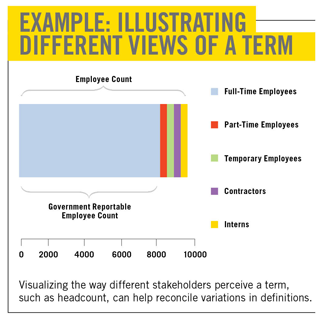5 Steps to Creating Effective Data Definitions
The emergence of business intelligence and data warehousing initiatives has placed increased importance on effective data governance practices among many business and IT leaders.
More often than not, organizations turn to IT groups to provide leadership in this area to ensure the quality, consistency, security and standardization of information across disparate business units. The key to an effective data governance program hinges on the development of strong, reusable data definitions.
Developing these definitions can be a tricky process, especially in organizations that have never tackled data governance on an enterprisewide basis before. Successful definition efforts require a consensus-driven approach that considers the requirements of business units beyond the immediate user or customer to guarantee the long-term viability of definitions. These five steps can help an organization build an effective data governance program.
Step #1: Identify and Involve Stakeholders
Data governance is not a technology effort. While data governance programs are almost always driven or coordinated by IT, they're primarily social exercises.
The first step to take when developing a data definition is to put together a clear list of all of the individuals involved and invite them to participate in the development of the definition. It will be far easier to obtain their support for the eventual implementation of a new definition if they feel an ownership stake in the development process.
One great way to coordinate stakeholder involvement is through the use of a responsibility assignment, or RACI, matrix, similar to the one shown below.

A RACI is a simple spreadsheet with a row for each of the terms being defined and a column for each stakeholder or group of stakeholders. Stakeholders fill out the matrix based upon their level of involvement using one of four options:
- Responsible (R): Designates ownership of a term on an ongoing basis and the final decision-making authority for the definition that is created.
- Accountable (A): Identifies employees who will drive the definition process to completion. Depending upon organizational structure, these could be the same people "responsible" for the final approval of a definition; or, accountability could be a central data governance function.
- Consult (C): Describes employees who want to or will actively participate in drafting and refining a term.
- Inform (I): Refers to anyone who doesn't feel that he or she needs to actively contribute but would like to be informed of the definition and any future changes.
This approach allows each group to self-select its level of involvement, saving the IT team from a problematic "I didn't have a chance to give input" encounter down the road.
Step #2: Obtain Executive Support from the Beginning
Developing data definitions is extremely time-consuming. Many organizations find the average definition takes between 10 and 20 hours to develop, with some complex terms taking far longer. Complicating this is the fact that the data definition team must obtain that commitment of time from all corners of the business.
Success in obtaining these resources is dependent upon having strong executive support for data governance efforts. If leadership visibly supports this work, obtaining commitments will be far easier than trying to accomplish it as a grass-roots effort.
Step #3: Eliminate Jargon and Use Simple Language
One of the biggest stumbling blocks to developing consistent definitions is the bureaucratic jargon that pervades many organizations. In many cases, even individual units have their own internal language not shared by others within the business. Using this type of terminology in data definitions can be a recipe for disaster. If the team working on the definitions begins to sound like the characters in the movie "Office Space" discussing TPS reports, call a timeout and put things back on track.
One way to drive jargon out of data governance efforts is to adopt the "interested bystander" principle. Following this rule requires developing definitions that employ language simple enough that any individual with a basic understanding of the business could comprehend their meaning. Sure, an employee might need technical details about how to retrieve that information from the data warehouse, but save the technical detail for another section of the data dictionary and write the definition in plain English.

Step #4: Visually Reconcile Differences
In instances where groups differ on the details of a definition, it often helps to draw a picture that clearly identifies the issues that need to be discussed.
For example, if attempting to develop a consistent definition for employee headcount, the human resources staff might share numbers that represent what they typically pre-sent in a personnel report, while a group responsible for government reporting might have a completely different number in mind. If the definition team can draw a picture like the one at right, it will help highlight the differences.
Sometimes the use of a picture can reconcile the differences so the team can come up with a single definition. If not, the team can use the identified differences to build a series of terms. For instance, in the headcount example, the team might wind up with "Employee Count" and "Government Reported Employee Count" and be able to identify the specific classes of individuals that fall under one definition but not the other.
Step #5: Start Conversations with a Draft Rather than a Blank Piece of Paper
It helps to use whatever knowledge already is known to write a draft before walking into the first meeting. Share that draft in advance with the caveat that it might be completely wrong. It's far easier for a group to edit a draft than it is to start with an empty template to create definitions. Providing a draft at the start cuts down on the time spent "wordsmithing" and allows for jumping right into a substantive conversation.
Data governance efforts require a significant investment of time, energy and political capital. But by focusing consensus and applying a few basic principles, a company can create an effective and efficient development process that results in definitions that deliver solid business value.








